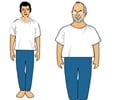The ideal weight of a person depends on their skeletal frame size, which can be classified as Large, Medium, or Small, as bone size and density vary between individuals and genders. Before starting a weight loss diet, it's important to determine your frame size using this calculator. Body frame size can be assessed using either wrist circumference or elbow breadth (
1✔).
You can also use
height and that can help you find your Frame Size, using another medindia calculator.
To measure your wrist circumference, find the point just below your wrist bone, which is the narrowest part of the wrist, and measure it here for the most accurate result (
2✔).


What is Body Frame Size and How it is Determined?
Body frame size refers to the relative size of a person's bones, which is typically assessed by measuring the wrist or elbow breadth in relation to their height. It provides a way to categorize individuals into different body types (11✔,12✔)
Body frame size is often classified into three main categories:
- Small Frame: Smaller wrist size relative to height, indicating a finer bone structure.
- Medium Frame: Average wrist size in relation to height, representing a balanced bone structure.
- Large Frame: Larger wrist size relative to height, indicating a larger bone structure.
How to Calculate Body Frame Size Using 'Wrist circumference' Measurement?
Calculating Body Frame Size using wrist circumference is straightforward. Follow these steps (13✔):
Step 1: Measure Your Wrist Circumference
- Use a flexible measuring tape.
- Wrap the tape around the smallest part of your wrist (just above the bony protrusion).
- Record the measurement in inches or centimeters.
Step 2: Determine Your Height in inches or centimetersStep 3: Use the Wrist Circumference to Height RatioCompare your wrist circumference to your height to determine your body frame size. Here's how (
14✔):
For Women: | Height Range (Women) | Wrist Size | Body Frame Size |
| Shorter than 5' 2" (157.5 cm) | Smaller than 5.5" (14 cm) | Small |
| | 5.5" to 5.75" (14 cm - 14.6 cm) | Medium |
| | Larger than 5.75" (14.6 cm) | Large |
| 5' 2" to 5' 5" (157.5 cm - 165 cm) | Smaller than 6" (15.25 cm) | Small |
| | 6" to 6.25" (15.25 cm - 15.9 cm) | Medium |
| | Larger than 6.25" (15.9 cm) | Large |
| Women Taller than 5' 5" (165 cm) | Smaller than 6.25" (15.9 cm) | Small |
| | 6.25" to 6.5" (15.9 cm - 16.5 cm) | Medium |
| | Larger than 6.5" (16.5 cm) | Large |
For Men: | Height Range (Men) | Wrist Size | Body Frame Size |
| Men Taller than 5' 5" (165 cm) | 5.5" to 6.5" (14 cm - 16.5 cm) | Small |
| | 6.5" to 7.5" (16.5 cm - 19 cm) | Medium |
| | Larger than 7.5" (19 cm) | Large |
Formula to calculate Body Frame Size using ‘Wrist circumference’ measurement
Medindia Body Frame Size Calculator uses the following validated formula:
Frame Size=Height/ Wrist Circumference (WrC) (
15✔)
Finger and Thumb Test
Finger and Thumb Test is another simple and quick test that determines body frame size based on how your thumb and index finger overlap or touch around your wrist (
16✔).
Method: Place your thumb and index finger around your wrist to determine frame size.
- Small Frame: Finger overlaps thumb.
- Medium Frame: Fingers just touch.
- Large Frame: Fingers do not touch.
How to Calculate Body Frame Size using 'Elbow Breadth' measurement?
Measuring elbow width or breadth can be somewhat tricky, especially if you're doing it alone without assistance. Here's how it's typically done (4✔):
- Use a flexible measuring tape and you can measure either in centimeters or inches.
- The individual should stand upright, facing the person conducting the measurement.
- The right arm should be stretched forward so that it's perpendicular to the body.
- The forearm is then raised to create a 90-degree angle, with the fingers pointing upwards.
- The person measuring then determines the widest part of the elbow for the measurement (3✔).
Refer to the height table below and then use the information to determine your frame size. The body frame size is categorized into three groups - small, medium and large. The calculation is fairly simple (
4✔).
Small Frame: If the elbow measurement is lesser than the value given in the table for a given height.
Medium Frame: If the elbow measurement ranges between the values given in the table for a given height.
Large Frame: If the elbow measurement is greater than the value given in the table for a given height (
14✔).
Formula to Calculate Body Frame Size using ‘Elbow Breadth' Measurement:
Medindia Body Frame Size Calculator uses the following formula (
17✔):
Frame Index (mm) = (Elbow breadth [mm]/height [cm]) × 100
Implication of Body Frame Size on Health
Frame size is categorized into small, medium, and large and have various implications on health:
- Small Frame Size: Individuals with a smaller frame may have a lower body mass index (BMI) but this doesn't always indicate better health. They might still be at risk for conditions like osteoporosis, especially if they have low bone density.
- Medium Frame Size: Often considered as 'average', this frame size is generally associated with a balanced BMI. Health risks are typically standard and not specifically heightened due to frame size alone.
- Large Frame Size: Those with a larger frame might have a higher BMI, which can sometimes lead to misconceptions about their health status. A larger frame doesn't necessarily equate to obesity or poor health, but it may be associated with a higher risk of certain conditions like cardiovascular diseases or type 2 diabetes, particularly if excess weight is a factor (18✔).
Role of Genetics in Body Shape:Genetics largely determines one's baseline body type and shape, including bone structure, frame size, fat distribution, and metabolism. However, health outcomes can be influenced by lifestyle choices such as maintaining a balanced diet and engaging in regular exercise (
5✔).
In all cases, it's important to remember that frame size is just one aspect of health. A balanced diet, regular exercise, and proper medical care are crucial for maintaining good health, regardless of frame size.
Apple and Pear Body Shapes: Any frame size can have an
apple-shaped body, characterized by more fat around the abdomen or
pear-shaped body, having more fat around the thighs. Apple-shaped body are at a greater risk of heart disease, diabetes, and stroke. Those with a pear-shaped body might have a lower metabolic risk, but they are still at risk of
metabolic syndrome (
6✔).
In all cases, it's important to remember that frame size is just one aspect of health. A balanced diet, regular exercise, and proper medical care are crucial for maintaining good health, regardless of frame size (
7✔).
FAQs on Body Frame Size?
1. Can I change my body frame type?
The simple answer is no as it is determined by genetics and is
inherited (8✔).
2. Is there an ideal frame size?
There is no "ideal" frame size as such, as frame size varies greatly
among individuals and is largely determined by genetics and bone
structure. What's considered healthy or ideal for one person might not be the same for another.
It's important to understand that different frame sizes can be healthy
and normal. Health assessments, including those related to weight and fitness, should take into account an individual's unique frame size, rather than conforming to a universal standard. This perspective
supports a more personalized and accurate approach to health and
wellness.
3. If I am short will I be of large frame?
No, a short person can be small, medium, or large frame depending on
their bone structure and muscle mass.
4. Can I be tall and still be small frame?
Yes, as frame size depends not only on your height but also on bone
structures and measurements.
5. Between frame size or waist size which has more implications
on my health?
Waist size is a crucial measure for predicting health risks. A waist
size of more than 35 inches in women and more than 40 inches in men is considered risky, indicating excessive visceral fat and making them prone to heart disease and diabetes (9✔).
6. Why is frame size important?
Frame size can influence optimal weight ranges, nutritional needs,
and health risks, and it plays a role in how individuals respond to
diet and exercise.
7. Does a larger frame mean I am unhealthy?
Not necessarily. People with larger frames can be just as healthy as
those with smaller frames. It's more about overall body composition
and lifestyle factors that determine health.
8. Is frame size considered in BMI calculations?
No, BMI calculations do not take frame size into account, which is why
additional methods of body composition analysis are often recommended for a more accurate health assessment (10✔).

 Email
Email




















The measurement is of wrist or elbow?